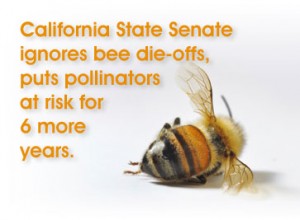25
Aug
California Passes Bill That Mandates Response to Bee Crisis, but Delays Action until 2020
(Beyond Pesticides, August 22, 2014) In a blow to the adoption of urgently needed protections for pollinators, the California State Senate voted 35-1, after an earlier Assembly vote of 75-0, to delay a requirement for action on bee-harming neonicotinoid (neonic) pesticides until 2020. While advocates want mandates for regulatory action to protect bees, the timeline in the bill ignores that ongoing crisis faced by bees, beekeepers, and agriculture dependent on bee pollination. Assembly Bill 1789 provides the California Department of Pesticide Regulation (CalDPR) another four years to reevaluate neonicotinoid pesticides, and an additional two years to implement any measures that would be needed to protect pollinator health. Given that CalDPR began its reevaluation of neonics in 2009, and existing law would have required a complete reevaluation within two years, the legislature’s new 2020 timeline has been met with strong criticism from beekeepers and environmental groups.
The passage of AB 1789 sets the CalDPR on a track similar to the U.S. Environmental Protection Agency’s (EPA) timeline for neonic review. This timeline is widely seen as an unacceptable response to the pollinator crisis, given unsustainable declines of greater than 30% of managed honey bee colonies each year, and widespread adverse impacts on other wild pollinators. “The Department of Pesticide Regulation has been dithering since 2009, while our bees continue to die in droves, and this bill essentially tells the department to sit on its hands for another six years,” said Greg Loarie, attorney at EarthJustice, “AB 1789 will amount to a death sentence for honey bees.” Last December a broad coalition of more than 60 organizations, including Beyond Pesticides, launched a national media campaign to tell EPA that “Bees can’t wait 5 more years, and neither can we.”
A large and expanding collection of scientific literature links pollinator declines to the use of neonicotinoid pesticides, a class of systemic insecticides that make their way into the pollen, nectar, and dew droplets on which pollinators forage. Scientists across the world are sounding the alarm on neonicotinoids and other systemic insecticides, and demanding action from legislators and regulatory bodies. According to a Wordwide Integrated Assessment undertaken by the Global Task Force on Systemic Pesticides, neonics and their breakdown products are persistent and harmful to pollinators and wildlife even at very low levels. Researchers explain, “The existing literature clearly shows that present day levels of pollution with neonicotinoids and fipronil caused by authorized uses, frequently exceed lowest observed adverse effect concentrations for a wide range of non-target species and are thus likely to have wide ranging negative biological and ecological impacts.” In a recent study published in the Bulletin of Insectology by scientists at the Harvard School of Public Health, pesticides, not mites or pathogens, as has been claimed by the chemical industry, were found to be the major cause of honey bee hive deaths. Even before the release of these two documents, an analysis of the science conducted by Beyond Pesticides had concluded that our pollinator crisis is “No Longer A Big Mystery.”
To the dismay of pollinator supporters, as the science continues to link the role of neonics in bee declines, the CalDPR has continued to allow expanded uses of neonicotinoids in the state. Beyond Pesticides, Pesticide Action Network, and Center for Food Safety, represented by Earthjustice, recently filed the legal challenge in the California Superior Court for the County of Alameda, urging the California Department of Pesticide Regulation (DPR) to stop approving neonicotinoid pesticides pending its completion of a comprehensive scientific review of impacts to honeybees.
One in every three bites of food depends on bees for pollination, and the annual value of pollination services worldwide are estimated at over $125 billion. In the United States, pollination contributes $20-30 billion in agricultural production annually. And in California alone, almonds crops ”” entirely dependent on bees for pollination ”” are valued at over $3 billion. Last year, serious questions surrounded whether there would be enough honey bees available to pollinate the state’s almond crops. Without strong, meaningful protections for honey bees and other wild pollinators coming from government officials in California, these problems are not likely to subside.
At the end of Pollinator Week 2014, the President Obama directed executive agencies to develop a plan to address pollinator declines within 180 days. It is imperative those concerned about pollinator health put pressure on the President to protect pollinators from harmful pesticides, so that real long lasting protections come from this announcement. After all, given the success of organic production systems, these chemicals simply are not necessary to grow food or successfully manage pests.
To become more involved in pollinator protection, visit the BEE Protective campaign page. BEE Protective is a joint initiative launched by Beyond Pesticides and the Center for Food Safety, aimed at protecting honey bees and other pollinators from pesticides and contaminated landscapes.
Source: EarthJustice, California Legislative Information
All unattributed positions and opinions in this piece are those of Beyond Pesticides.











Disgusting lack of judgement & ethics! So sick of these guys not doing the right thing. I hear scientists are trying to create a GMO/robot bee, figures they’d kill our bees so they can profit off fake ones just like they did with our food.
August 25th, 2014 at 10:11 amCalifornia was once the leader.
Not any more, I am sorry to say.
Soaked with pesticides, herbicides, GMOS, and corruption, the Central Valley seems to becoming a vast cemetery. So much potential has been dissipated —thanks to American “Agriculture.” 20th-century American Agriculture must surely be the single greatest “scientific” fraud and technological failure in world history.
Pesticides, herbicides, and GMOS — we call that “science” in America.
August 25th, 2014 at 10:52 pm